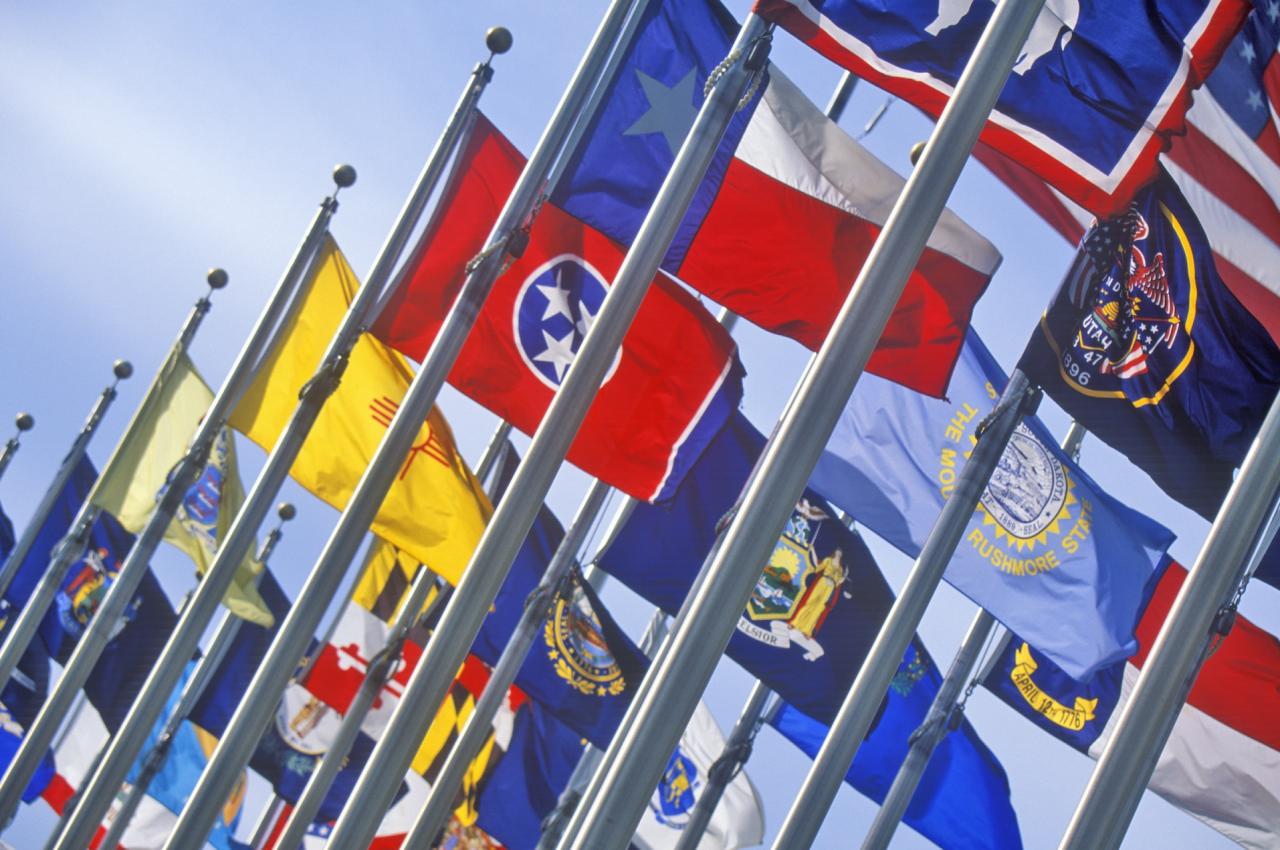When an Old Flag Isn’t So Grand
Though less famous than the stars and stripes, the flags that mark each state are part of America’s national fabric. They appear on local flagpoles and occasionally in corporate and athletic logos.
Many states have been reevaluating and updating their state flags to remove controversial seals or insignia. Tufts’ home state of Massachusetts, whose flag includes an arm holding a sword and an image of a Native American, is one of a handful of states currently in a redesign. The multi-year process, which has involved commissions, public hearings, and about 1,000 flag design submissions, has revealed strong and often differing opinions on what images and words best encapsulate the state.
Tufts political science professor Deborah Schildkraut is doing research on the updating of state flags and how they’re tied to state identity—how people perceive a state and its values. She says the topic is particularly relevant in 2025, when whether state policies align with federal ones or take an opposing tack may affect the connection residents feel with their home state.
Tufts Now spoke with her about the impact of state flags and state identity on civic engagement and how citizens’ relationships to their state identities are shifting in the current political climate.
What is the value of having state flags?
Flags are meant to signal identity and cohesion. They are symbolic, and while we might be tempted to dismiss symbols as fun or without substance—state cookie? state dinosaur?—they also communicate information about a place’s history and culture.
Massachusetts’ current state flag (top) and the three finalist contenders for the new design, which feature a mayflower, waves and a star on a hill, and turkey feathers. Images: Massachusetts Seal, Flag, and Motto Commission
People involved in debates about redesigning their state’s flag acknowledge that there can be valuable political outcomes if a state can foster a sense of unity and pride among its residents, and there can be positive economic outcomes if a state markets itself well to outsiders.
One of the topics I’m researching now is state identity and pride, and I’m looking into political outcomes that go along with that. For example, one of my recent studies finds that people are more likely to engage in some forms of political activity if they have higher levels of state pride. If we feel that more political participation is better, then state pride can be beneficial. And maybe symbols, like flags, have a role to play in fostering that sensibility. I’m also starting a new study that looks into whether state pride can reduce partisan polarization.
Why are states changing their flags?
The 2020 murder of George Floyd in Minneapolis, and the nationwide mass mobilization for racial justice that followed, was an important catalyzing event. Those marches and rallies sparked broad conversations about history, identity, inclusion, and repair. State flags, mottos, and symbols got brought into that discussion.
One of the first flags to be redesigned in that aftermath was the flag of Mississippi. Its old flag had Confederate imagery. Discussions about replacing it had come up for years, but it wasn’t until 2020 that the change finally took place. Since then, 10 states have either redesigned or started thinking about redesigning their state flags. And citizen-led efforts are asking their states to do the same elsewhere. So that’s a lot of Americans living in places going through these processes.
To what extent do state flags relate to state identity? How does changing the flags impact that?
We don’t have a lot of data to answer these questions. I would expect that what happens with other provocative policies that affect identity and inclusion would happen with flags as well.
For example, I did research on how people respond when states adopt more welcoming or unwelcoming policies with regard to immigration. When it comes to welcoming policies, there can be fear among politicians that it will hurt their reelection prospects, and residents may fear negative consequences from accommodating immigrants.
But after policies are put in place, it turns out that people report feeling that they like where they live, that they feel like it is a welcoming place, and they feel that they belong, and yet they can’t necessarily articulate why. The policy works under the radar.
When a state is unwelcoming, however, people know about it, they can mention specific policies that create tension, and they say that the policies make them feel less at home.
So regarding a flag change, I would think that at first there would be anger among some people and even attempts to bring back the old flag. That’s happened in some states that have recently changed their flags. But over time people will get used to the new flag. And if the new flag is designed well, according to recommendations from flag experts called vexillologists, then people will even want to start displaying the flag in all sorts of places, even in tattoos!
More generally, have you noticed changes in perceptions of state identities in the past few years?
Yet again, a great question for which we don’t have great data, because people in my line of work haven’t really been asking people about state identities until recently. Our data on the question of how connected people feel to their states just doesn’t go back very far.
What I can say is that several political scientists, in addition to myself, have gotten interested in this question recently, and it’s not a coincidence that several of us have started researching this topic at the same time.
In addition to the discussions about state identities that have emerged after the 2020 racial justice movement, political polarization at the national level has generated vibrant state policymaking activity on many national hot-button issues, like immigration, abortion, voting rights, and gun rights. And in our current political moment, several states are engaged in high profile and high stakes conflicts with the Trump administration, and those conflicts can have an impact on people’s relationships with their states.
There’s an op-ed that ran in the Washington Post right after the 2024 election that I like to cite as emblematic of this possibility, and it was titled “My blue state is my country now.” I feel like that title captures a lot of the things I’m interested in studying more these days.













